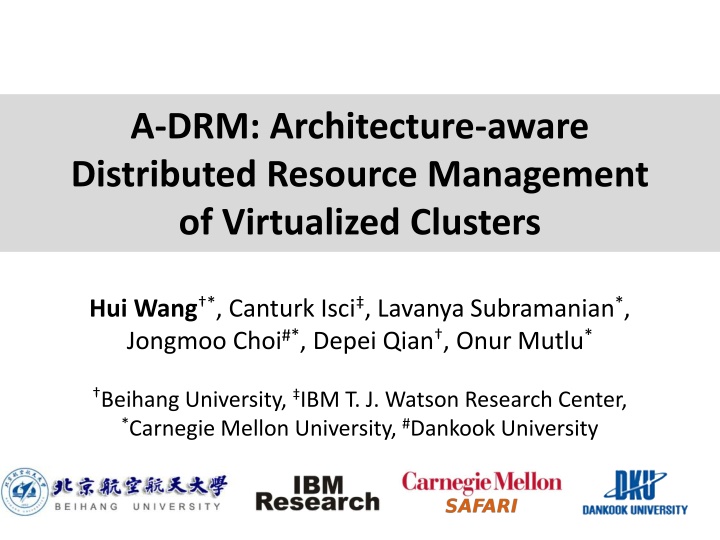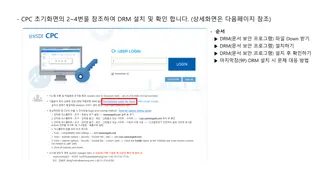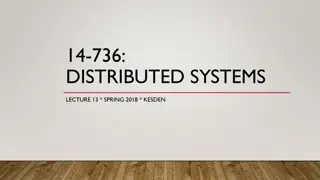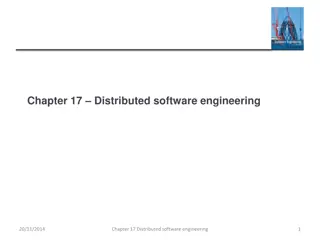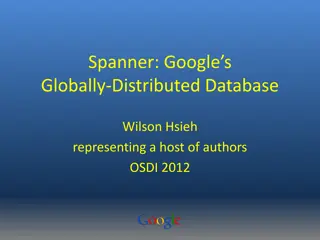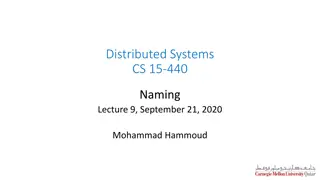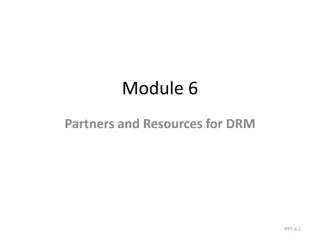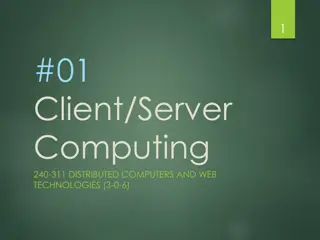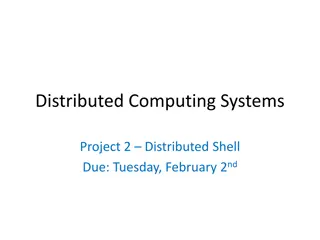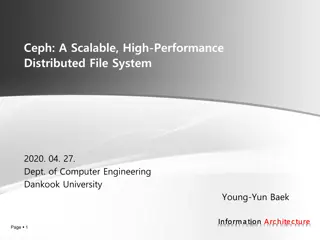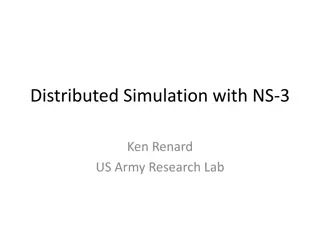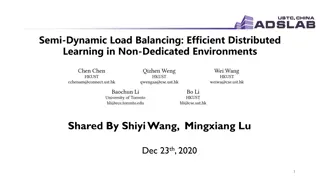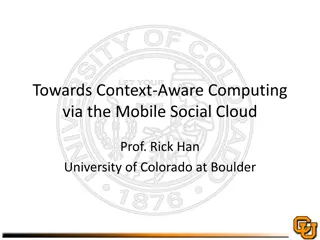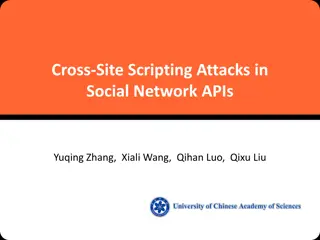A-DRM: Architecture-aware Distributed Resource Management
Virtualized Clusters dynamically schedule Virtual Machines across physical hosts using Architecture-aware Distributed Resource Management (A-DRM), which aims to maximize cluster performance by monitoring and balancing microarchitecture-level shared resources. This approach addresses the lack of visibility into resource interference, resulting in higher performance and memory bandwidth utilization compared to conventional DRM techniques.
Download Presentation

Please find below an Image/Link to download the presentation.
The content on the website is provided AS IS for your information and personal use only. It may not be sold, licensed, or shared on other websites without obtaining consent from the author.If you encounter any issues during the download, it is possible that the publisher has removed the file from their server.
You are allowed to download the files provided on this website for personal or commercial use, subject to the condition that they are used lawfully. All files are the property of their respective owners.
The content on the website is provided AS IS for your information and personal use only. It may not be sold, licensed, or shared on other websites without obtaining consent from the author.
E N D
Presentation Transcript
A-DRM: Architecture-aware Distributed Resource Management of Virtualized Clusters Hui Wang *, Canturk Isci , Lavanya Subramanian*, Jongmoo Choi#*, Depei Qian , Onur Mutlu* Beihang University, IBM T. J. Watson Research Center, *Carnegie Mellon University, #Dankook University
Executive Summary Virtualized Clusters dynamically schedule a set of Virtual Machines (VM) across many physical hosts (called DRM, Distributed Resource Management) Observation: State-of-the-art DRM techniques do not take into account microarchitecture-level resource (cache and memory bandwidth) interference between VMs Problem: This lack of visibility into microarchitecture-level resources significantly impacts the entire virtualized cluster s performance Our Goal: Maximize virtualized cluster performance by making DRM microarchitecture aware Mechanism: Architecture-aware Distributed Resource Management (A- DRM): 1) Dynamically monitors the microarchitecture-level shared resource usage 2) Balances the microarchitecture-level interference across the cluster (while accounting for other resources as well) Key Results: 9.67% higher performance and 17% higher memory bandwidth utilization than conventional DRM 2
Virtualized Cluster VM VM VM VM App App App App How to dynamically schedule VMs onto hosts? (DRM) policies Distributed Resource Management Host Host Core0 Core1 Core0 Core1 LLC LLC DRAM DRAM 3
Conventional DRM Policies Based on operating-system-level metrics e.g., CPU utilization, memory capacity demand VM VM App App App App Memory Capacity Host Host VM CPU App Core0 Core1 Core0 Core1 LLC LLC DRAM DRAM 4
Microarchitecture-level Interference Host VMs within a host compete for: Shared cache capacity Shared memory bandwidth VM VM App App Core0 Core1 LLC DRAM Can operating-system-level metrics capture the microarchitecture-level resource interference? 5
Microarchitecture Unawareness Microarchitecture-level metrics Operating-system-level metrics VM LLC Hit Ratio Memory Bandwidth CPU Utilization Memory Capacity 2% 2267 MB/s 92% 369 MB App 98% 1 MB/s 93% 348 MB Host Host Memory Capacity VM VM VM VM VM App App CPU App App App Core0 Core1 Core0 Core1 STREAM LLC LLC gromacs App DRAM DRAM 6
Impact on Performance 0.6 IPC 0.4 (Harmonic Mean) 0.2 0.0 Conventional DRM with Microarchitecture Awareness Host Host Memory Capacity VM VM VM VM VM App App CPU SWAP App App App Core0 Core1 Core0 Core1 STREAM LLC LLC gromacs App DRAM DRAM 7
Impact on Performance 0.6 49% IPC 0.4 (Harmonic Mean) 0.2 0.0 Conventional DRM We need microarchitecture- level interference awareness in DRM! with Microarchitecture Awareness Host Host Memory Capacity VM VM VM VM VM App App CPU App App App Core0 Core1 Core0 Core1 STREAM LLC LLC gromacs App DRAM DRAM 8
Outline Motivation A-DRM Methodology Evaluation Conclusion 9
A-DRM: Architecture-aware DRM Goal: Take into account microarchitecture-level shared resource interference Shared cache capacity Shared memory bandwidth Key Idea: Monitor and detect microarchitecture-level shared resource interference Balance microarchitecture-level resource usage across cluster 10
Conventional DRM Controller Hosts DRM: Global Resource Manager OS+Hypervisor Profiling Engine VM VM App App Distributed Resource Management (Policy) CPU/Memory Capacity Profiler Migration Engine 11
A-DRM: Architecture-aware DRM Controller Hosts A-DRM: Global Architecture aware Resource Manager OS+Hypervisor Profiling Engine VM VM Architecture-aware Interference Detector App App Architecture-aware Distributed Resource Management (Policy) CPU/Memory Capacity Architectural Resource Resources Architectural Profiler Migration Engine 12
Architectural Resource Profiler Leverages the Hardware Performance Monitoring Units (PMUs): Last level cache (LLC) Memory bandwidth (MBW) Reports to Controller periodically 13
A-DRM: Architecture-aware DRM Controller Hosts A-DRM: Global Architecture aware Resource Manager OS+Hypervisor Profiling Engine VM VM Architecture-aware Interference Detector App App Architecture-aware Distributed Resource Management (Policy) Architectural Resource Resources Architectural CPU/Memory Profiler Migration Engine 14
Architecture-aware Interference Detector Goal: Detect shared cache capacity and memory bandwidth interference Memory bandwidth utilization (MBWutil) captures both: Shared cache capacity interference Shared memory bandwidth interference Host VM VM Key observation: If MBWutil is too high, the host is experiencing interference App App Core0 Core1 LLC DRAM 15
A-DRM: Architecture-aware DRM Controller Hosts A-DRM: Global Architecture aware Resource Manager OS+Hypervisor Profiling Engine VM VM Architecture-aware Interference Detector App App Architecture-aware Distributed Resource Management (Policy) Architectural Resource Resources Architectural CPU/Memory Profiler Migration Engine 16
A-DRM Policy Two-phase algorithm Phase One: Goal: Mitigate microarchitecture-level resource interference Key Idea: Suggest migrations to balance memory bandwidth utilization across cluster using a new cost- benefit analysis Phase Two: Goal: Finalize migration decisions by also taking into account OS-level metrics (similar to conventional DRM) 17
A-DRM Policy: Phase One Goal: Mitigate microarchitecture-level shared resource interference Employ a new cost-benefit analysis to filter out migrations that cannot provide enough benefit Only migrate the least number of VMs required to bring the MBWutil below a threshold (MBWThreshold) Source Destination VM VM VM VM App App App App Core0 Core1 Core0 Core1 High MBW LLC LLC Low MBW App DRAM DRAM 18
A-DRM Policy: Phase Two Goals: Finalize migration decisions by also taking into account OS-level metrics Avoid new microarchitecture-level resource hotspots Source Destination VM VM VM VM App App App App Core0 Core1 Core0 Core1 High MBW LLC LLC Low MBW App DRAM DRAM 19
A-DRM Policy Two-phase algorithm Phase One: Goal: Mitigate microarchitecture-level resource interference Key Idea: Suggest migrations to balance memory bandwidth utilization across cluster using a new cost- benefit analysis Phase Two: Goal: Finalize migration decisions by also taking into account OS-level metrics (similar to conventional DRM) 20
The Goal of Cost-Benefit Analysis For every VM at a contended host, we need to determine: If we should migrate it Where we should migrate it For each VM at a contended source, we consider migrating it to every uncontended destination We develop a new linear model to estimate the performance degradation/improvement in terms of time 21
Cost-Benefit Analysis Costs of migrating a VM include: 1) VM migration cost (?????????????), 2) Performance degradation at the destination host due to increased interference (???????) Benefits of migrating a VM include: 1) Performance improvement of the migrated VM (?????????), 2) Performance improvement of the other VMs on the source host due to reduced interference (??????????) src dst VM VM VM VM VM Phase One of A-DRM suggests migrating a VM if App App App App App Core0 Core1 Core0 Core1 ?????????+ ??????????> ?????????????+ ??????? LLC LLC DRAM DRAM 22
Cost-Benefit Analysis Costs of migrating a VM include: 1) VM migration cost (?????????????), 2) Performance degradation at the destination host due to increased interference (???????) Benefits of migrating a VM include: 1) Performance improvement of the migrated VM (?????????), 2) Performance improvement of the other VMs on the source host due to reduced interference (??????????) Phase One of A-DRM suggests migrating a VM if ?????????+ ??????????> ?????????????+ ??????? 23
?????????????: VM migration VM migration approach used in A-DRM: Pre-copy-based live migration + timeout support High cost since all of the VM s pages need to be iteratively: scanned, tracked transferred The migration time can be estimated similar to conventional DRM policies 24
Cost-Benefit Analysis Costs of migrating a VM include: 1) VM migration cost (?????????????), 2) Performance degradation at the destination host due to increased interference (???????) Benefits of migrating a VM include: 1) Performance improvement of the migrated VM (?????????), 2) Performance improvement of the other VMs on the source host due to reduced interference (??????????) Phase One of A-DRM suggests migrating a VM if ?????????+ ??????????> ?????????????+ ??????? 25
???????: Performance Degradation at dst The migrated vm competes for: Shared cache capacity Shared memory bandwidth dst VM VM vm App App App Performance at dst degrades due to: Increase in memory bandwidth consumption Increase in the memory stall time experienced by VMs Core0 Core1 LLC DRAM 26
Cost-Benefit Analysis Costs of migrating a VM include: 1) VM migration cost (?????????????), 2) Performance degradation at the destination host due to increased interference (???????) Benefits of migrating a VM include: 1) Performance improvement of the migrated VM (?????????), 2) Performance improvement of the other VMs on the source host due to reduced interference (??????????) Phase One of A-DRM suggests migrating a VM if ?????????+ ??????????> ?????????????+ ??????? 27
?????????: Performance improvement of vm The performance of migrated vm improves due to: Lower contention for memory bandwidth Lower memory stall time src dst VM VM vm VM App App App App Core0 Core1 Core0 Core1 LLC LLC DRAM DRAM 28
Cost-Benefit Analysis Costs of migrating a VM include: 1) VM migration cost (?????????????), 2) Performance degradation at the destination host due to increased interference (???????) Benefits of migrating a VM include: 1) Performance improvement of the migrated VM (?????????), 2) Performance improvement of the other VMs on the source host due to reduced interference (??????????) Phase One of A-DRM suggests migrating a VM if ?????????+ ??????????> ?????????????+ ??????? 29
??????????: Performance improvement at src src The performance at src improves due to: Reduced memory bandwidth consumption Reduced stall time experienced by VMs VM VM App App Core0 Core1 LLC DRAM 30
A-DRM Policy Two-phase algorithm Phase One: Goal: Mitigate microarchitecture-level resource interference Key Idea: Suggest migrations to balance memory bandwidth utilization across cluster using a new cost- benefit analysis Phase Two: Goal: Finalize migration decisions by also taking into account OS-level metrics (similar to conventional DRM) 31
Outline Motivation A-DRM Methodology Evaluation Conclusion 32
Evaluation Infrastructure 2/4 dual-socket Hosts Two 4-core Xeon L5630 Processors (Westmere-EP) with hyperthreading disabled L1/L2/shared LLC: 32KB/256KB/12MB One 8GB DDR3-1066 DIMM per socket Host VM Images placed in shared storage (NAS) Socket 2 Socket 1 OS and Hypervisor: Fedora 20 with Linux Kernel version 3.13.5-202 QEMU: 1.6.2 Libvirt: 1.1.3.5 DRAM Core Core Core Core Core Core Core Core QPI LLC LLC DRAM 33
DRM Parameters Baseline: Conventional DRM [Isci et al., NOMS 10] Parameter Value CPU overcommit threshold (???? ??? ???) Memory overcommit threshold (???? ??? ???) Memory bandwidth threshold (???? ??? ???) DRM scheduling interval (?? ??????? ????????) 90% 95% 60% 300 seconds DRM sliding window size 80 samples Profiling interval (????????? ????????) 5 seconds Live migration timeout (???? ????????? ???????) 30 seconds 34
Workloads 55 Workloads chosen from: PARSEC (10) SPEC CPU 2006 (28) NAS Parallel Benchmark (14) STREAM (1) Microbenchmark (2) Classified based on memory intensity: memory-intensive (memory bandwidth larger than 1GB/s) memory-non-intensive 35
Outline Motivation A-DRM Methodology Evaluation 1. Case Study 2. Heterogeneous Workloads 3. Per-Host vs. Per-Socket Interference Detection Conclusion 36
1. Case Study 14 VMs on two 8-core hosts Initially: Host A: 7 memory-intensive VMs (STREAM) Host B: 7 memory-non-intensive VMs (gromacs) Host State MBW Demand Memory Bandwidth Enough H Memory Bandwidth Starved L Host A Host B 37
100 CPU_ALL(A) Host A Host B CPU Util [%] 50 0 CPU_ALL(B) 0 300 100 Mem Capacity Util [%] MEM_ALL(A) 50 0 MEM_ALL(B) 0 300 100 MBW Util [%] MBW_ALL(A) 50 0 MBW_ALL(B) 0 300 38 Host A Host B
100 CPU_ALL(A) Host A Host B CPU Util [%] 50 0 CPU_ALL(B) 0 300 600 100 Mem Capacity Util [%] MEM_ALL(A) 50 0 MEM_ALL(B) 0 300 600 100 MBW Util [%] MBW_ALL(A) 50 0 MBW_ALL(B) 0 300 600 39 Host A Host B
100 CPU_ALL(A) Host A Host B CPU Util [%] 50 0 CPU_ALL(B) 0 300 600 900 100 Mem Capacity Util [%] MEM_ALL(A) 50 0 MEM_ALL(B) 0 300 600 900 100 MBW Util [%] MBW_ALL(A) 50 0 MBW_ALL(B) 0 300 600 900 40 Host A Host B
100 CPU_ALL(A) Host A Host B CPU Util [%] 50 0 CPU_ALL(B) 0 300 600 900 100 Mem Capacity Util [%] MEM_ALL(A) 50 0 MEM_ALL(B) 0 300 600 900 100 MBW Util [%] MBW_ALL(A) 50 0 MBW_ALL(B) 0 300 600 900 By migrating VMs using online measurement of microarchitecture-level resource usage, A-DRM: Mitigates resource interference Achieves better memory bandwidth utilization 41 Host A Host B
Outline Motivation A-DRM Methodology Evaluation 1. Case Study 2. Heterogeneous Workloads 3. Per-Host vs. Per-Socket Interference Detection Conclusion 42
2. Heterogeneous workloads 28 VMs on four 8-core hosts Unbalanced placement according to intensity Workloads (denoted as iXnY-Z): X VMs running memory-intensive benchmarks Y VMs running memory-non-intensive benchmarks Z indicates the two different workloads under the same intensity 43
Performance Benefits of A-DRM 30% IPC Improvement [%] 25% 20% 15% 9.7% 10% 5% 0% i14n14-1 average i07n21-1 i07n21-2 i08n20-1 i08n20-2 i09n19-1 i09n19-2 i10n18-1 i10n18-2 i11n17-1 i11n17-2 i12n16-1 i12n16-2 i13n15-1 i13n15-2 i14n14-2 i15n13-1 i15n13-2 i16n12-1 i16n12-2 i17n11-1 i17n11-2 i18n10-1 i18n10-2 i19n09-1 i19n09-2 i20n08-1 i20n08-2 i21n07-1 i21n07-2 Compared to traditional DRM scheme: Performance improves by up to 26.6%, with an average of 9.7% The higher the imbalance between hosts, the greater the performance improvement 44
Number of Migrations 16 12 6 8 4 0 average i07n21-1 i07n21-2 i08n20-1 i08n20-2 i09n19-1 i09n19-2 i10n18-1 i10n18-2 i11n17-1 i11n17-2 i12n16-1 i12n16-2 i13n15-1 i13n15-2 i14n14-1 i14n14-2 i15n13-1 i15n13-2 i16n12-1 i16n12-2 i17n11-1 i17n11-2 i18n10-1 i18n10-2 i19n09-1 i19n09-2 i20n08-1 i20n08-2 i21n07-1 i21n07-2 The higher the imbalance between hosts, the greater the number of migrations 45
Cluster-wide Resource Utilization Traditional DRM A-DRM Resource Utilization 1.20 Normalized 1.10 1.00 0.90 CPU MEM MBW Average memory bandwidth utilization improves by 17% Comparable CPU and memory capacity utilization 46
Outline Motivation A-DRM Methodology Evaluation 1. Case Study 2. Heterogeneous Workloads 3. Per-Host vs. Per-Socket Interference Detection Conclusion 47
Per-Host vs. Per-Socket Interference Detection Host B Host A Socket 1 Socket 2 Socket 1 Socket 2 VM VM VM VM VM VM VM VM App App App App App App App App Core Core Core Core Core Core Core Core QPI QPI LLC LLC LLC LLC DRAM DRAM DRAM DRAM Per-Host Per-Socket 48
Performance Benefits of Per-Host vs. Per-Socket Per-Host Detection Per-Socket Detection Relative IPC Improvement 25% 20% 15% 10% 5% 0% Per-Socket Detection achieves better IPC improvement than Per-Host Detection 49
Outline Motivation A-DRM Methodology Evaluation Conclusion 50
